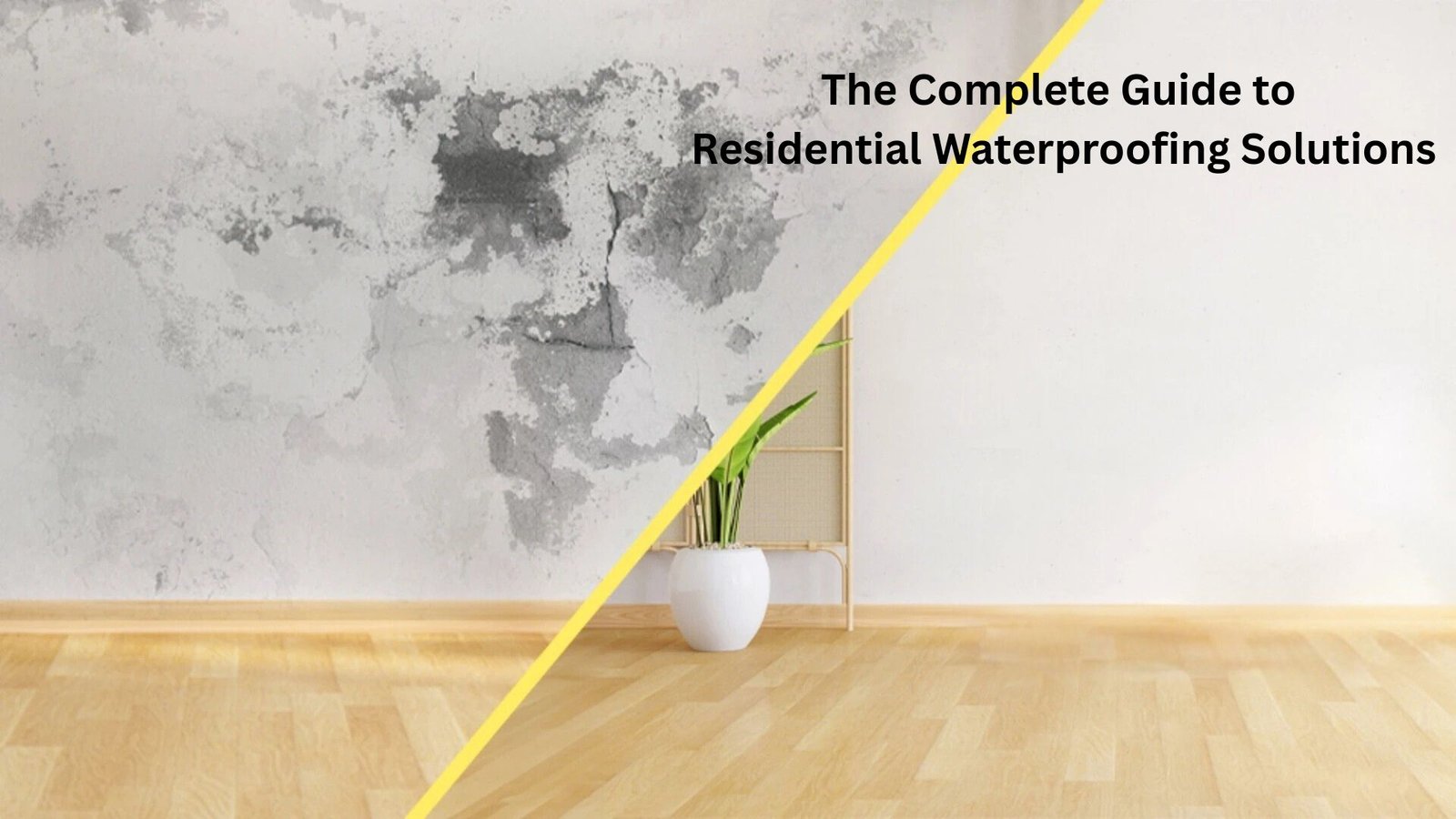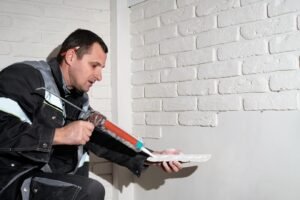
Leaky basement? Cracked walls? Mold creeping in? Residential waterproofing isn’t just for rainy days; it protects everything under your roof. From basement leaks to foundation cracks, these silent problems grow fast and cost more later. This guide shows how home waterproofing keeps damage out and value in. Learn the smartest waterproofing solutions, what they cost, and how to choose what really works. Ready to protect your home before ‘,things get worse? Let’s get into it.
Why You Really Need Home Waterproofing
Skip waterproofing, and your home pays the price. Think water stains, damp smells, or worse, cracked walls and costly damage. Moisture sneaks in fast and doesn’t leave quietly. That’s why residential waterproofing isn’t optional. It keeps your space safe, dry, and solid. You save money. You avoid stress. And your property stays strong for years. Let’s break down what can really happen when there’s no plan for home waterproofing, and how the right waterproofing solutions help protect what matters.
Fixing Water Damage Is Expensive
Water doesn’t just leave a stain. It breaks things down. Flooring, paint, and furniture suffer quickly. Small leaks lead to big bills. With proper water damage prevention, you avoid paying twice. First for the damage, then for the fix. Save money with early action. Moisture control today means fewer repairs tomorrow. Skip the headaches. Waterproofing now is smarter than waiting for things to fall apart. It’s not about spending. It’s about protecting what you’ve already paid for.
Mold Grows Fast and Stays Long
Mold loves dark, damp corners. Once it grows, it spreads. And it smells. Bad. It can even trigger allergies. Proper moisture control keeps your home dry and mold-free. You don’t want your basement turning into a science experiment. Waterproofing blocks mold before it starts. It keeps the air clean and your walls dry. Don’t give mold a place to live. Keep it out with smart waterproofing solutions and simple home waterproofing steps.
Your Foundation Can Start to Break
Water seeps deep. Over time, it softens the ground under your house. Cracks start small but grow fast. That’s when your home’s structure gets shaky. You need real foundation protection, not just patch jobs. Strong residential waterproofing keeps water from reaching the base of your house. No moisture, no cracks. You protect the core of your home. It’s easier to sleep when you know your house is standing on solid, dry ground.
You Could Face Serious Structural Damage
Water doesn’t stop at walls. It goes for the whole structure. Wooden frames can rot. Steel can rust. Over time, that means sagging floors and warped walls. Smart waterproofing solutions stop these problems before they start. Every drop you keep out is one less risk. Foundation protection matters. So does keeping everything dry from the roof to the crawl space. Your home stays strong when water stays out. Simple as that.
Clear Warning Signs Your Home Needs Waterproofing
Water doesn’t always knock before it enters. Sometimes, it just leaves behind signs. A strange smell, stained walls, or damp air can all mean trouble is creeping in. Don’t ignore these clues. They’re small signals of bigger problems. If you’ve asked, “Does my home need waterproofing?”, the answer might already be in front of you. Let’s look at key signs of water damage and why a waterproofing inspection can’t wait.
Musty Smells
A musty smell isn’t just annoying. It’s a major red flag. If the air feels heavy or damp, it’s time to ask yourself, “Does my home need waterproofing?” A professional waterproofing inspection helps you find the source. Don’t ignore a musty smell. It rarely goes away on its own.
Water Stains on Walls
Brown spots on your walls or ceiling? That’s not just old paint, it’s a warning. Water stains are one of the most obvious signs of water damage. They often mean a leak is coming from the roof, pipes, or even through your foundation. Stains grow over time and bring mold with them. Don’t paint over the problem. A smart waterproofing inspection helps you catch the real cause. Waterproofing keeps stains away and protects your walls from future damage.
Cracks in Foundation
Tiny cracks might seem harmless, but they’re often a quiet sign of pressure from trapped moisture. Over time, those cracks get wider. Water sneaks in. Then things get worse. If you notice lines forming in basement walls or around the base of your home, it’s time to act. These are classic signs of water damage. Ask for a waterproofing inspection and protect your home from the inside out. Cracks don’t fix themselves. And they never stay small.
Peeling Paint or Efflorescence
Paint that bubbles, flakes, or peels usually means moisture is sitting behind the surface. Efflorescence, the white chalky stuff on walls, is another warning. It means water has passed through the wall and left behind salt. Both are clear signs of water damage and poor moisture control. These issues don’t just look bad, they weaken the structure. Don’t keep repainting. That’s a temporary fix. Get a full waterproofing inspection to solve the real problem and stop water for good.
Frequent Basement Flooding
A wet basement isn’t normal. It’s a sign your home is letting water in, and fast. Flooding damages floors, ruins furniture, and attracts mold. If it happens more than once, don’t wait. You likely need serious moisture control and better drainage. A waterproofing inspection shows where water is sneaking in and how to keep it out. This isn’t just about comfort. It’s about safety and long-term home protection. Don’t let the next storm bring another flood.
High Indoor Humidity
Too much humidity inside your house makes everything feel damp. t usually means water is entering somewhere. This is a silent but serious sign of water damage. A full waterproofing inspection can point out hidden leaks or cracks.
Types of Residential Waterproofing Solutions
Not all water problems need the same fix. Some start under your home, others come from above. That’s why picking the right residential waterproofing method matters. From hidden leaks to full-blown basement floods, there’s a smart solution for each problem. This guide breaks down the best interior waterproofing, exterior waterproofing, and crawl space waterproofing methods. We’ll also cover tools like sump pumps and waterproof membranes so you can protect your home the right way.
Interior Waterproofing
Interior waterproofing focuses on stopping water that’s already inside. It helps control moisture, manage leaks, and keep basements dry. These solutions are great for managing water without digging up your yard.
Sump Pumps
Sump pumps push out water collected in a pit. It’s one of the most reliable ways to prevent flooding. A well-installed sump pump works automatically. This gives you peace of mind during heavy rain. It’s a smart choice if your basement floods often or if your home sits on a low plot.
Interior Drainage Systems
These systems collect and redirect water under the floor or behind walls. They usually send water to a sump pump or drain. It’s a solid option if you’re dealing with water seepage or damp walls. The good part? It’s all hidden, so your basement still looks clean. If you want to keep your space dry without tearing up the yard, this interior waterproofing method works well.
Vapor Barriers
A vapor barrier stops moisture from passing through surfaces like walls and floors. It works well in crawl spaces and basements. It’s a low-cost way to fight dampness before it causes bigger issues. A good barrier gives you extra protection in problem areas.
Waterproof Coatings
Waterproof coatings are great for unfinished spaces like basement walls. They also help reduce musty smells and peeling paint. They’re perfect for light dampness. Think of them as an extra shield for your interior.
Exterior Waterproofing
Exterior waterproofing stops water before it even touches your foundation. It’s more involved but offers long-term protection. These methods usually require digging and installing materials outside your home.
Foundation Excavation & Membrane Installation
This is one of the most thorough exterior waterproofing methods. The soil around your foundation is removed. Then a waterproof membrane is placed on the wall to keep moisture out. It’s best for homes with serious water issues or large cracks. Once done, it protects your foundation from water pressure and soil moisture. It’s a bigger job but gives solid results for years.
Exterior Drainage Tiles
These are pipes placed around the outside of your home to carry water away. They sit near the foundation and work with gravel to improve drainage. This method is best when you have poor runoff or lots of standing water. It pairs well with foundation protection systems and helps prevent leaks from happening in the first place. If you want to stop the water at the source, drainage tiles are a great option.
Waterproof Sealants
These are thick coatings applied to the outer walls of your foundation. They block rain, groundwater, and other moisture. Sealants are often used with membranes and tiles to boost protection. While not a fix for heavy flooding, sealants work great for small cracks and light moisture. They also help extend the life of your foundation and keep it strong through all seasons.
Roof and Crawl Space Waterproofing
Roof and crawl space problems are easy to miss but cause big damage. Crawl space waterproofing and roof sealing stop mold, rot, and high indoor moisture.
Roof Membranes
A roof membrane is a protective layer that prevents leaks. It covers the roof and blocks water from soaking into the structure. These membranes come in rolls or sheets and work well on flat or low-slope roofs. If your attic feels damp or you’ve spotted ceiling stains, this can be a smart fix. Pair it with proper gutters to keep water flowing off your roof.
Gutter and Drainage Management
Gutters keep rainwater away from your home’s walls and foundation. Clogged or broken ones send water where it shouldn’t go. Fixing and managing your gutter system is a simple way to stop bigger issues. Add downspout extenders and make sure your lawn slopes away from the house. It’s basic, but it works. Good drainage protects every part of your home.
Learn why Harrington Paving is Nebraska’s go-to contractor for lasting results. and whether it’s foundation drainage, failing pavement, or site grading,
Crawl Space Encapsulation
This crawl space waterproofing method seals the space with heavy plastic sheets. It blocks water, reduces humidity, and improves air quality. Encapsulation also keeps bugs and pests away. It’s perfect for homes in humid climates or with low ventilation. By sealing the crawl space, you keep moisture out and structure safe.
What’s Better: DIY or Hiring a Pro for Waterproofing?
What Does Waterproofing Really Cost?
Waterproofing cost depends on the method and how bad the damage is. Small interior waterproofing jobs can cost a few hundred dollars. Bigger foundation waterproofing projects go into thousands. Exterior waterproofing costs more because it involves digging and sealing from the outside. Still, it’s worth it. Waterproofing boosts your home’s value and saves you from expensive repairs. Ask a pro, “How much does waterproofing cost?” They’ll give a clear estimate based on your home’s needs.
Waterproofing Cost Breakdown
How to Choose the Right Waterproofing Solution
Choosing the best waterproofing method depends on a few key factors. Here’s what you should consider:
Check the Damage
Is it just a small leak or a full basement flood? Bigger problems need professional solutions.
Look at the Location
Basement, roof, or bathroom? Every area needs a different waterproofing method.
Set Your Budget
Some options are cheap and temporary. Others cost more but last longer.
Think About the Weather
If your area gets a lot of rain or humidity, choose a stronger solution.
Get a Free Waterproofing Assessment
Experts can suggest the right fix after inspecting your home.
Conclusion
Waterproofing keeps your home safe and your wallet happy. Small leaks can turn into big problems if ignored. Don’t wait until your basement smells or your walls crack. Act early and save thousands in repairs.
Need help? Get a free inspection from our trusted waterproofing contractor today. We’ll help you stay dry, safe, and stress-free.
FAQs
What is residential waterproofing?
Why do I need waterproofing?
Can I do waterproofing myself?
How much does waterproofing cost?
How do I know I need waterproofing?
What’s the best waterproofing method?
How long does waterproofing last?
Author




Pingback: Why Harrington Paving Is Neligh, NE’s #1 Asphalt Contractor